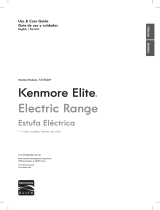
50
GARANTÍA LIMITADA
PROCEDIMIENTO PARA RESOLVER CONFLICTOS:
TODOS LOS CONFLICTOS ENTRE USTED Y LG QUE SURJAN FUERA DE O RELACIONADOS DE ALGUNA MANERA CON ESTA GARANTÍA LIMITADA O
CON EL PRODUCTO, SE RESOLVERÁN EXCLUSIVAMENTE A TRAVÉS DE UN ARBITRAJE VINCULANTE Y NO EN UNA CORTE DE JURISDICCIÓN GENERAL.
ARBITRAJE VINCULANTE SIGNIFICA QUE USTED Y LG RENUNCIAN AL DERECHO DE UN JUICIO CON JURADO Y A REALIZAR O PARTICIPAR EN UNA
DEMANDA COLECTIVA.
Definiciones. Para el propósito de esta sección, las referencias a “LG” significan: LG Electronics U.S.A., Inc., sus empresas matrices, subsidiarias y
filiales y cada uno de sus directivos, directores, empleados, agentes, beneficiarios, predecesores en interés, sucesores, cesionarios y proveedores;
las referencias a “conflicto” o “reclamación” incluirán cualquier conflicto, reclamo o controversia de cualquier tipo, sin importar (ya sea basado en
contrato, agravio, estatuto, regulación, ordenanza, fraude, falsa representación o cualquier teoría legal o equitativa) que surja de o esté relacionada
con cualquier forma de venta, condición o desempeño del producto o de esta Garantía Limitada.
Aviso de disputa. En caso de que usted desee iniciar un procedimiento de arbitraje, primero debe notificar a LG por escrito al menos 30 días antes
de iniciar el arbitraje enviando una carta a LG a LG Electronics, USA, Inc. Atención: Legal Department- Arbitration 1000 Sylvan Ave, Englewood
Cliffs 07632. Usted y LG aceptan participar en discusiones de buena fe en un intento de resolver su reclamo de manera amistosa. En la carta
debe proporcionar su nombre, dirección y número de teléfono; identificar el producto que es objeto de la reclamación; y describir la naturaleza
del reclamo y el remedio que busca. Si usted y LG no pueden resolver la disputa dentro de 30 días, cualquiera de las partes pueden proceder a
presentar una demanda de arbitraje.
Acuerdo de arbitraje vinculante y renuncia de demanda colectiva. En caso de no resolver la disputa durante el período de 30 días después de
enviar una notificación por escrito a LG, Usted y LG se comprometen a resolver cualquier reclamo entre nosotros, solamente a través de arbitraje
vinculante sobre una base individual, a menos que usted se excluya, conforme a lo dispuesto a continuación. Cualquier conflicto entre usted y LG
no estarán combinados o consolidados con una controversia relacionada con cualquier otro producto o reclamo de otra persona o entidad. Más
específicamente y sin prejuicio de lo anterior, no procederá bajo ninguna circunstancia cualquier disputa entre usted y LG como parte de una
acción colectiva o representativa. En lugar del arbitraje, cualquiera de las partes podrá iniciar una acción individual en la corte de reclamos menores,
pero tales acciones en la corte de reclamos menores no podrán ser realizadas en una acción colectiva o representativa.
Normas y procedimientos de arbitraje. Para comenzar con el arbitraje de un reclamo, usted o LG deben realizar una demanda escrita para
arbitraje. El arbitraje será administrado por la Asociación Americana de Arbitraje (AAA) y se llevará a cabo ante un árbitro único bajo las Normas
de Arbitraje del Consumidor de la AAA, que tienen efecto al momento de inicio del arbitraje (en adelante “Normas de la AAA”) y bajo los
procedimientos establecidos en esta sección. Las Normas de la AAA están disponibles en línea en www.adr.org/consumer. Envíe una copia de su
solicitud de arbitraje por escrito, así como una copia de esta disposición, a la AAA de la forma descrita en las Normas de la AAA. También debe
enviar una copia de su solicitud por escrito a LG en LG Electronics, USA, Inc. Atención: Legal Department- Arbitration 1000 Sylvan Ave, Englewood
Cliffs 07632. Si hay un conflicto entre las Normas de la AAA y las reglas establecidas en esta sección, prevalecerán dichas reglas de esta sección. Esta
disposición de arbitraje se rige por la Ley Federal de Arbitraje. El juicio se pueden introducir en el laudo arbitral en cualquier tribunal de jurisdicción
competente. Todos son temas para que el árbitro tome sus decisiones, excepto aquellos asuntos relativos al alcance y aplicabilidad de la cláusula de
arbitraje y de la capacidad de arbitraje de la controversia para que el tribunal decida. El árbitro se regirá por los términos de esta disposición.
Legislación vigente. La legislación del estado de su residencia regirá esta Garantía Limitada, así como todas las disputas entre nosotros, salvo que
sea invalidada o inconsistente con leyes federales aplicables.
Tarifas / Costos. Usted no debe pagar ninguna tarifa para comenzar un arbitraje. Al recibir su solicitud de arbitraje por escrito, LG pagará todos los
gastos administrativos rápidamente a la AAA, a menos que usted solicite más de $25,000.00 por daños, en cuyo caso el pago de estos gastos se
regirá por las Normas de la AAA. Salvo disposición contraria prevista en el presente documento, LG pagará a la AAA todos los gastos documentales,
administrativos y de arbitraje para cualquier arbitraje iniciado, de conformidad con las Normas de la AAA y esta disposición de arbitraje. Si usted
prevalece en el arbitraje, LG pagará los honorarios y gastos de sus abogados, siempre y cuando sean razonables, considerando factores que
incluyen, entre otros, el monto de la compra y el monto del reclamo. No obstante lo anterior, si la ley aplicable permite una adjudicación de
honorarios y gastos razonables de abogados, un árbitro pueden otorgarlos en la misma medida que lo haría un tribunal. Si el árbitro considera que
la sustancia de su reclamo o la reparación solicitada en la demanda es frívola o se utiliza para un propósito inadecuado (calificado según las normas
establecidas en la Norma Federal de Procedimiento Civil 11 (b)), el pago de todos los honorarios de arbitraje se regirá por las Normas de la AAA. En
tal situación usted se compromete a reembolsar a LG todos los fondos erogados previamente por ella, cuyo pago es, por otra parte, su obligación,
según las Normas de la AAA. Salvo disposición contraria, LG renuncia a cualquier derecho que pudiera tener para solicitarle los honorarios y gastos
de sus abogados, si LG prevalece en el arbitraje.
Audiencias y ubicación. Si su reclamo es por $25,000 o menos, usted pueden optar que el arbitraje sea realizado únicamente sobre la base de: (1)
documentos presentados al árbitro, (2) a través de una audiencia telefónica o (3) por una audiencia en persona, según lo establecido por las Normas
de la AAA. Si su reclamo excede $25,000, el derecho a una audiencia estará determinado por las Normas de la AAA. Cualquier audiencia de arbitraje
en persona se realizará en un lugar dentro del distrito judicial federal en el cual resida, a menos que ambos acuerden otra ubicación o estemos de
acuerdo con el arbitraje telefónico.
Exclusión. Usted pueden quedarse fuera de este procedimiento de resolución de la disputa. Si se excluye, ni usted ni LG pueden solicitar al otro
que participe en un procedimiento de arbitraje. Para excluirse usted debe enviar una notificación a LG, en un lapso de hasta 30 días continuos,
contados a partir de la fecha de la primera compra del consumidor del producto, ya sea por: (i) el envío de un correo electrónico a optout@lge.com
con el siguiente Asunto: “Exclusión del arbitraje” o (ii) llamada al 1-800-980-2973. Debe incluir en el correo electrónico de exclusión o suministrar
por teléfono: (a) su nombre y dirección; (b) la fecha en la cual el producto fue comprado; (c) el nombre o el número del modelo del producto; y (d) el
número del serial (el número del serial pueden ser hallado (i) en el producto, o (ii) en la dirección de https://www.lg.com/us/support/repair-service/
schedule-repair-continued al hacer clic en “Find My Model & Serial Number”).
Sólo pueden excluirse del procedimiento de resolución de conflictos en la forma descrita anteriormente (es decir, por correo electrónico o por
teléfono); ninguna otra forma de notificación será efectiva para hacerlo. Excluirse de este procedimiento de resolución de controversias no afectará
de ninguna manera la cobertura de la Garantía Limitada, por lo que usted continuará disfrutando de todos sus beneficios. Si conserva este producto
y no se excluye, usted acepta todos los términos y condiciones de la cláusula de arbitraje descrita anteriormente.




































































































